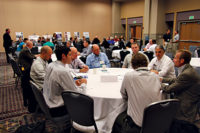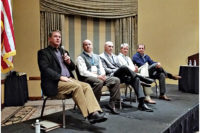Green buildings at St. Francis of Assisi Church in Raleigh, N.C., are true to the spirit of its patron saint.

Pope John Paul II officially named St. Francis of Assisi the patron saint of ecology in 1979. It’s only natural then that the parishioners of the Catholic Community of St. Francis of Assisi in Raleigh, N.C., should take stewardship of the environment as seriously as they do.
“St. Francis is our saint,” says parishioner Tina Subasiac, who is a certified architect. “Stewardship of the environment is part of our tradition and faith.”
It also was an important factor in the design and construction of three buildings that the U.S. Green Buildings Council has certified as meeting LEED Gold standards. USGBC representatives presented the certifications during a ceremony at the church early last year.
The LEED Gold buildings are the Assisi Community Center, Elizabeth Hall Preschool and St. Mary of the Angels Chapel. A fourth building, the middle school, was certified as LEED Silver earlier this year. The total cost of construction on all four buildings was $13 million.
“Receiving any certification is an accomplishment; receiving four awards is indeed a rarity and reflects our parish’s 29-year history of concern for our environment,” says Marc Kielty, coordinator of ministry support. “This is an outstanding achievement as we will be one of the only church communities on the East Coast with the distinction of four LEED buildings.”
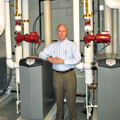
Green features
The Catholic Community of St. Francis of Assisi has occupied the Raleigh site since 1983. The campus sits on 30 acres and includes educational as well as religious facilities.
The parish consists of 5,000 families and employs 140 people. School enrollment includes 680 students from kindergarten through eighth grade and another 200 preschoolers.
Sustainable features incorporated into the entire campus include:
-
Water needed for landscaping has been reduced by at least 50% by using drought-tolerant plants and rain barrels to collect water for plants.
-
Concrete sidewalks and parking lots reflect sunlight to avoid solar heat gain.
-
All buildings utilize a green cleaning program, which avoids the use of harmful chemicals and uses paper products with recycled content.
- During the construction project, more than 20% of all materials used in the buildings came from sources within 500 miles of the campus. More than 90% of all construction waste was diverted from landfills.
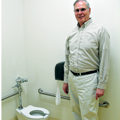
A key element in the buildings achieving LEED Gold certification is their superior performance in the area of energy efficiency, Kielty says. Each of the new buildings is designed to use at least 51% less energy than a comparable building.
The new buildings’ HVAC system makes use of outside air recirculation, humidity control and zoning that can be controlled centrally from a laptop computer. Mechanical equipment includes Lochinvar Knight Boilers and A.O. Smith water heaters.
“We conducted guided tours for the parishioners, students and employees,” Director of Operations Ben Whitehouse says. “The functionality of the systems was well received. We’re proud of what we did here and want to educate the groups that come in. It’s been very worthwhile.”
Each of the buildings has its own green features. The Community Center houses a gym, a youth room, a coffee café and a senior center. The center’s low-flow faucets, toilets and urinals have reduced water consumption by 52% over standard models. The wood floor and subfloor in the gym come from sustainably harvested forests. Priority parking is designated for low-emissions and fuel-efficient vehicles such as hybrids and for carpools.
Each classroom in the preschool is equipped with individual controls for lighting and temperature control to ensure comfort and energy efficiency. The water-based paint on the walls does not emit fumes and the cabinets in the classrooms are made from recycled wood products that avoid the use of toxic glue.
The St. Mary of the Angels Chapel’s brick floors and carpet eliminate potential harmful vapors associated with many traditional flooring products. The chapel’s many windows help eliminate the need for electric lighting, which saves energy and money.
The windows also provide a view of the property’s natural woodlands, which were preserved to protect the pre-existing habitat. A wetland in the middle of the campus also was preserved during the construction project.
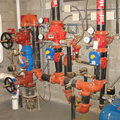
Financial commitment
At the beginning of the process in 2004, the church conducted a town hall-style meeting with parishioners to lay out plans for the project and answer questions. Funding for the new construction was split evenly between money raised from parishioners and a loan from the Catholic Diocese of Raleigh.
The timing of the actual construction during the economic downturn relieved the financial burden to some degree.
“Construction costs were depressed during the recession,” Whitehouse says. “We were able to take advantage of that.”
Where the church did not see any favored savings was in money or time spent in applying for LEED certification for the new buildings.
“There’s no cost break on LEED for churches,” Whitehouse says.
The LEED process and paperwork took four to six months to complete. The church was able to save time by submitting its design to earn some LEED credits before the buildings were finished.
It helped that parishioners such as Subasiac and former EPA facilities manager Bill Laxton, who were well-versed in LEED, served on the parish building committee overseeing the project. The committee worked with architect Charles Todd of Little Diversified Architectural Consulting in Durham, N.C. The general contractor was Clancy & Theys Construction Co. in Raleigh. The site engineer was Ballentine Associates in Chapel Hill, N.C. The HVAC contractor was Piedmont Air Conditioning in Raleigh.
Three of the new buildings were dedicated on April 25, 2010, and USGBC informed the church of the LEED Gold certifications the following November. Attending the presentation ceremony Jan. 31, 2011, were religious, political and environmental leaders. These included Bishop Michael F. Burbidge of the Catholic Diocese of Raleigh; Very Reverend John F. O’Connor, minister provincial of the Holy Name Province; U.S. Rep. David Price, D-N.C.; Secretary Dee A. Freeman of the North Carolina Department of Environment and Natural Resources; and Raleigh Mayor Charles Meeker.
Despite their green features, the new buildings blend in well with the rest of the campus.
“I’m amazed at how the project turned out,” Whitehouse says. “Some buildings on the campus were built 25 years ago, and you can’t tell the difference between them and the new buildings.”

